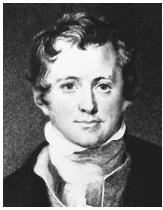Humphry Davy
ENGLISH CHEMIST
1778–1829

Sir Humphry Davy, the son of woodcarver, was born on December 17, 1778, in Penzance, Cornwall, then a highly industrialized area in the far west of England. In 1798 he moved to Bristol to work at the Pneumatic Institution under Thomas Beddoes, a physician who used gases for medicinal purposes. There he discovered the physiological properties of nitrous oxide (laughing) gas, which established his reputation as a chemist. In Bristol he became friends with the poets Samuel Taylor Coleridge and Robert Southey. No mean poet himself, Davy, at the suggestion of his friends, saw the second edition of William Wordsworth's Lyrical Ballads —that seminal text of English Romanticism—through to publication.
In 1801, at the age of twenty-two, Davy was appointed assistant professor and director of the laboratory at the newly founded Royal Institution (1799), and the following year he became professor of chemistry. In the eleven years that he was there, Davy firmly established the Royal Institution's reputation for excellent lectures on science and other areas of culture (he even influenced Coleridge to lecture there). In addition, he was a strong supporter of the utilitarian function of the Royal Institution, particularly in its application of chemical knowledge to the improvement of agriculture and industrial processes, in both of which Davy played a major role. But Davy also transformed the Royal Institution into a setting where in-depth scientific research would be carried out, something that its founders had not planned. But because of its commitment to providing spectacular lectures, the Royal Institution quickly came to have one of the best equipped laboratories in Europe, where research could be conducted.
During the first decade of the nineteenth century, Davy undertook fundamental work on electrochemistry following Alessandro Volta's invention of the electric battery at the end of the eighteenth century. Davy developed the first coherent theory of electrochemical action, whereby he argued that electrochemical decomposition took place at the metal poles through which electricity passed into a compound. Indeed, Davy posited that electrical force was the basis of all chemistry. During the course of his work, he discovered sodium and potassium, and later magnesium, calcium, strontium, and barium. Using the same electrochemical techniques, Davy eventually showed that chlorine and iodine were chemical elements rather than compounds, contrary to what French chemists had believed.
In 1812 he was knighted by the prince regent for his contributions to electrochemistry, married a wealthy widow Jane Apreece, and was thus able to retire from the Royal Institution at the age of thirty-four, although he remained the director of its laboratory. It was in this capacity that he appointed Michael Faraday as an assistant in the laboratory early in 1813. Later that year with his wife, her maid, and Faraday as an assistant, amanuensis (scribe), and reluctant valet, Davy embarked on an eighteen-month tour of the European continent, visiting many laboratories and sites of natural and cultural interest. On their return, Davy invented, with Faraday's assistance, the miners' safety lamp, which reinforced his reputation in applied science. With a confidence that was shared by all romantics of the time, Davy believed that nothing was beyond his reach, and in 1820 he was elected president of the Royal Society . This was a position he was ill-equipped to undertake after the forty-two-year presidency of Joseph Banks. Banks had been an autocratic president, and Davy had neither the ability to continue to lead in that mode, nor the power to take the society in a different direction. Davy sought to keep the peace between various factions within the society, but without success. His hostile attitude toward Faraday at this time was largely governed by the politics of the Royal Society. Davy's frustrations were compounded in the mid-1820s when his attempts to develop an electrochemical method for protecting the copper sheeting of the Royal Navy's ships failed. This resulted in strained relations between the government and the Royal Society, which culminated in the government abolishing the Board of Longitude, the only body then channeling state money into science. Davy suffered a stroke and resigned the presidency in 1827; he subsequently traveled abroad, where he died in Geneva, Switzerland, on May 29, 1829. Despite the ups and down of his career, during the nineteenth century Davy came to be regarded as a towering figure and a comparison with him was an enormous compliment.
SEE ALSO Barium ; Calcium ; Faraday, Michael ; Magnesium ; Potassium ; Sodium ; Strontium ; Volta, Alessandro .
Frank A. J. L. James
Bibliography
Davy, John, ed. (1839–1840). The Collected Works of Sir Humphry Davy. 9 vols. London: Smith, Elder and Co. (Reprinted with an introduction by David Knight, 2001, Bristol: Thoemmes Press.)
Fullmer, June Z. (2000). Young Humphry Davy: The Making of an Experimental Chemist. Philadelphia: American Philosophical Society.
Golinski, Jan (1992). Science as Public Culture: Chemistry and Enlightenment in Britain 1760–1820. Cambridge, U.K.: Cambridge University Press.
James, Frank A. J. L. (1992). "Davy in the Dockyard: Humphry Davy, the Royal Society and the Electro-chemical Protection of the Copper Sheeting of His Majesty's Ships in the Mid-1820s." Physis 29:205–225.
Knight, David (1998). Humphry Davy: Science and Power. Cambridge, U.K.: Cambridge University Press.
Miller, D. P. (1983). "Between Hostile Camps: Sir Humphry Davy's Presidency of the Royal Society of London 1820–1827." British Journal for the History of Science 16:1–47.
Comment about this article, ask questions, or add new information about this topic: